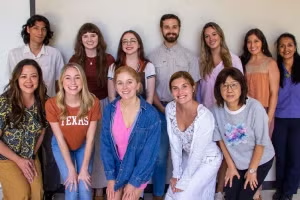The University of Texas System Board of Regents on Thursday will consider a $334 million plan to construct a medical school at The University of Texas at Austin.
Construction of the Dell Medical School will bring focus to the university’s diverse biomedical research as it helps transform community health care, UT Austin President Bill Powers told regents Wednesday.
Powers proposed a $334 million plan to construct research, educational and administrative facilities, as well as a medical office building and parking garage totaling 515,000 square feet. Seton Healthcare Family and Central Health, two other partners in the medical school effort, would build a new hospital as part of the campus.
The campus would be built on land already owned by the university and would be bounded by Interstate 35, Trinity Street, Martin Luther King Jr. Boulevard and 15th Street. The educational portion of the medical school would be built on what is now a parking lot directly across from the current University Medical Center Brackenridge hospital. The new hospital would be constructed next to the educational facility, and a research facility would be built adjacent to the new hospital.
Implementation of Phase I of the plan would not require removal of the Erwin Center, but a long-term proposal calls for the relocation of the venue in six to 15 years. Phase I would require the replacement of the Penick-Allison Tennis Center. The university’s Athletics Department will manage the relocation of the facility.
The Board of Regents Academic Affairs Committee voted Wednesday to recommend approval of the site plan for the Dell Medical School. The full Board of Regents is expected to vote Thursday.
“The site pIan for this project joins together the best in academic and community resources, and I’m very proud of the Board of Regents’ leadership in bringing this medical school to fruition,” said Gene Powell, chairman of the Board of Regents. “We are very excited because establishing a medical school on the campus of UT Austin is one more step to catapulting the university to even greater success, putting it in competition to be the finest public university in the nation.”
The Dell Medical School will be the fifth medical school in the UT System and the first medical school built in nearly four decades by a member of the Association of American Universities, an organization of leading public and private research universities.
“The new medical school campus will be part of our academic campus, and this will be a powerful connection,” Powers said. “Our medical students will be walking distance from some of the most innovative research in the world not only in medicine but in pharmacy, chemistry, medical business systems and biomedical engineering. They will be learning shoulder-to-shoulder with the other professionals who will be on their teams in the hospitals and clinics nurses, social workers and pharmacists as they treat patients. This will be a great place to learn transformative medicine.”
UT System Chancellor Francisco Cigarroa said the new medical school will support breakthrough biomedical research that will improve health care for the people of Central Texas and throughout the world.
“The UT Austin school of medicine was a key piece of the UT System’s Framework for Advancing Excellence, which was unanimously approved by the Board of Regents as part of our strategy to make UT Austin America’s finest university,” Cigarroa said. “We also are moving forward with full momentum to establish a medical school in the Rio Grande Valley, and together, these two medical schools will have a transformational impact on health care in Texas.”
Financing for the project would come from revenue bonds issued by UT Austin, backed by funding from the UT System and the Available University Fund, which is part of the state’s $19 billion endowment for UT and Texas AandM schools. The Board of Regents also has committed an additional $25 million a year for operating costs associated with the medical school.
The medical campus is part of a plan approved by Travis County voters in November 2012 that provided $35 million in local funding for medical services to the uninsured, filling a funding gap for ongoing medical school operations.
If the regents approve the plan, the university and its partners will begin detailed engineering studies on issues such as transportation, drainage and utilities.
The Dell Medical School is expected to open in summer 2016.




